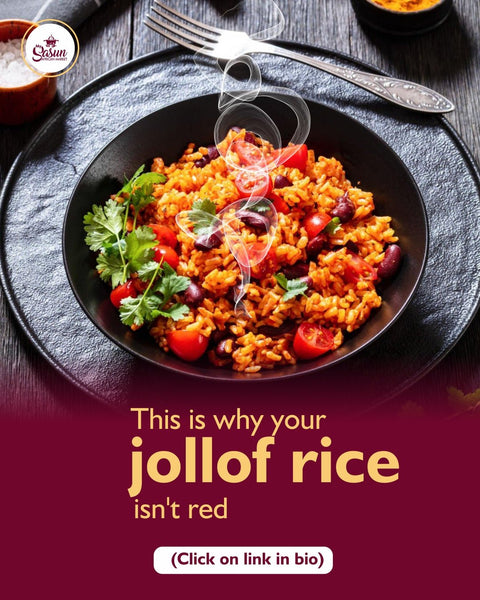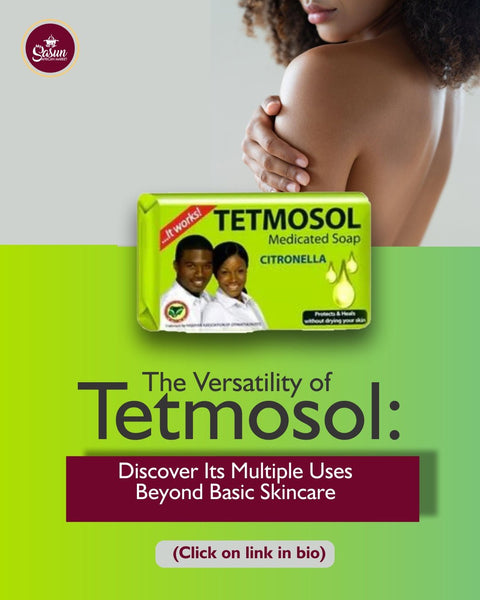Jollof rice, a vibrant and flavorful West African dish, is renowned for its rich red color. However, many home cooks often find themselves perplexed when their jollof rice turns out less than red. In this blog post, we will explore the reasons why your jollof rice might lack that desired red hue. So, let's dive in and uncover the secrets to achieving the perfect red jollof rice!
The Importance of Tomatoes in Jollof Rice
Tomatoes play a crucial role in the color, taste, and overall character of jollof rice. They provide the base for the sauce and contribute significantly to its vibrant red color. Not only do tomatoes add a tangy and slightly sweet flavor, but they also bring essential nutrients, such as vitamins A, C, and lycopene, to the dish.
READ 23 LEAFY VEGETABLES IN WEST AFRICAN CUISINE
The Variety of Tomatoes Matters
When it comes to jollof rice, the type of tomatoes you use can make a significant difference. Some tomatoes are naturally more vibrant and have a higher lycopene content than others. For that desired red hue, opt for ripe and juicy tomatoes such as Roma tomatoes or vine-ripened tomatoes. These varieties are known for their deep red color and rich flavor, making them ideal for jollof rice.

The Ripeness of Tomatoes
The ripeness of the tomatoes you choose for your jollof rice can affect its color. Ripe tomatoes are typically redder and have a stronger flavor. Avoid using unripe or under-ripe tomatoes, as they tend to be less vibrant and might result in a paler jollof rice. Look for tomatoes that are firm, fragrant, and deep red in color for the best results.
Tomato Paste: The Secret Ingredient
To intensify the red color of your jollof rice, tomato paste can be a game-changer. Tomato paste is a concentrated form of tomatoes, and its deep red color can enhance the overall appearance of your dish. Adding a spoonful or two of tomato paste to the sauce can give your jollof rice that extra boost of redness. Be mindful of the quantity, as too much tomato paste can overpower the other flavors.
Cooking Techniques and Timing
The way you cook your tomatoes can impact the color of your jollof rice. Overcooking tomatoes for extended periods can cause them to lose their vibrant red color. To preserve the color, lightly sauté the tomatoes and onions at the beginning of the cooking process, allowing them to release their flavors without excessive cooking. This way, you'll retain the bright red hue of the tomatoes throughout the preparation.
READ HOW TO PROPERLY SEASON MEAT

Other Factors Influencing Color
While tomatoes are the primary factor affecting the redness of jollof rice, other ingredients and cooking techniques can influence the color as well. The type and quantity of spices, such as paprika or cayenne pepper, can deepen the red tone. Additionally, the type of rice used and the cooking method can affect the final appearance. Parboiled rice, for instance, tends to produce a redder jollof rice than long-grain rice.
Rounding Off:
Next time you prepare this beloved West African dish, head to the local grocery store you can always count on, http://mysasun.com and carefully select ripe, juicy tomatoes that will lend a vibrant red hue to your jollof rice.
It's also worth noting that spices like paprika or cayenne pepper can deepen the red tone of your jollof rice. Experiment with these spices to achieve the desired level of color and heat.
Then, keep in mind that the type of rice you use can affect the final appearance of your jollof rice. Parboiled rice tends to result in a redder dish compared to long-grain rice. Consider your preferences and the traditional style of jollof rice you aim to achieve when selecting the rice variety.
In conclusion, the redness of your jollof rice largely depends on the tomatoes you choose, their ripeness, cooking techniques, and the addition of tomato paste. By paying attention to these factors, you can create a visually appealing and delicious jollof rice that will impress your family and friends.







Comments (8)
Powerful Herbal treatment is 100% guarantee for HSV cure, the reason why most people are finding it difficult to cure HSV 1 or 2 is because they believe on medical report, drugs and medical treatments which is not helpful to cure HSV and hasn’t proved any sign of helping. Natural roots/herbs are the best remedy which can easily eradicate herpes forever. I never believed it until I was helped and cured of my 16 months genital herpes with natural herbal medicines from Dr Sikies. Where other medical prescribed drugs and treatments failed, Dr Sikies natural herbs helped saved me from Genital herpes permanently and I’m so grateful for this. You can also get help from this great and powerful Herbalist Dr Sikies by reaching himon Email: drsikies@gmail.com / WhatsApp +2348163430143 website to make order now : https://drsikiesherbalcuremedicine.weebly.com/
Powerful Herbal treatment is 100% guarantee for HSV cure, the reason why most people are finding it difficult to cure HSV 1 or 2 is because they believe on medical report, drugs and medical treatments which is not helpful to cure HSV and hasn’t proved any sign of helping. Natural roots/herbs are the best remedy which can easily eradicate herpes forever. I never believed it until I was helped and cured of my 16 months genital herpes with natural herbal medicines from Dr Sikies. Where other medical prescribed drugs and treatments failed, Dr Sikies natural herbs helped saved me from Genital herpes permanently and I’m so grateful for this. You can also get help from this great and powerful Herbalist Dr Sikies by reaching himon Email: drsikies@gmail.com / WhatsApp +2348163430143 website to make order now : https://drsikiesherbalcuremedicine.weebly.com/
Got rid of herpes 1&2 completely, I started the treatment August 2022 for 14 days till now 2025 I have not had a single outbreak, All thanks to Dr. chalopa. It’s fascinating how they say it can’t be cured but here I am how Ironic. “For others like me out there”, there is a chance. He also treat other illnesses like HPV, HIV, PENIS ENLARGEMENT, DIABETES, and More. Email drchalopa@gmail. com
Living with Herpes simplex was depression for me even with my doctor’s advice and medication. My name is Vicky Moore I live in Chicago, Illinois and this is my story. I browsed the Internet in search of remedies or something but unfortunately nothing new, all still had the same results. Sadly I almost quit on myself, it was around 7:30 in the morning when my therapist called me over to her house, at first I was skeptical, but I went anyways on getting there she was smiling and said there’s living proof now, she showed me a lady who also suffered from herpes simplex 3years back and now she is cured by a doctor who also studied natural herbs. I was amazed and lost for words I even doubted but showed me a doctor’s report test. So I contacted the doctor and weeks later, I was cured. So I would love to use this medium to say a big thank you to my therapist and Dr. Chalopa. This story is shared to others like me out there. However, he also treats other illnesses. Email drchalopa@gmail.com
Am here to let the whole world know that I was diagnose of herpes 3 years ago where all hope was lost and I had nothing to do about it,I just accepted the faith that one day I will cure of this disease and I just pray everyday for a helper and one day my sister introduce me to a herbal doctor man called Dr ahonsie that she saw him on internet well I contact him on his email,I was not fully convinced until he sent me the herbal medicine which he ask me to take for two weeks I took it with faith and i went for a retest in different hospitals and today am cured of this disease and am also using this medium to let all those having STD,like herpes and the rest not to give up,their is a man who can cure you,his name is Dr ahonsie . contact the great herbalist via his Email: drahonsie00@gmail.com / WhatsApp: +2348039482367. https://drahonsie002.wixsite.com/dr-ahonsie
Hello everyone, i have a very important information about herpes virus, i was a victim of hsv1&2 until i met doctor Ahonsie, it still feels like a dream to me. it has been two years now, i have not experience any breakout of herpes. I new about him through a post made on social media, a lady shares her experience and then i decided to contact him and ever since i contacted i was encourage and with no doubt i was cured from herpes simplex in just two weeks. He also treat other illnesses like HPV, HIV, CANCER, THYRIOD, PENIS ENLARGEMENT, and more contact him via Email: drahonsie00@gmail.com / WhatsApp: +2348039482367. https://drahonsie002.wixsite.com/dr-ahonsie https://www.facebook.com/drstellaherbalhome?mibextid=ZbWKwLThanks
I thought the physicians says there is no cure for HSV 2!!! I am telling you today that Dr ahonsie cure HSV 2 with his herbal medicine and once you get cured you are cured forever it is never reversible, I have been suffering for this deadly disease called h HSV 2 for more than a 2years and lost all hope because my doctor says there is no cure for HSV 2. Brethren I saw a testimony on the internet on how Dr ahonsie cure HSV, Hapatitis etc with his herbal medication and an email and watsapp to contact him was also displayed, I thought this was joke but I decided to contact him and he replied telling me not to worry that my problem is over . Dr ahonsie sent me a herbal medication to drink for one month but only 2weeks I feel strange and I went to my doctor and he confirmed me negative. He can help you too. Contact him drahonsie00@gmail.com or whatsapp +2348039482367 https://drahonsie002.wixsite.com/dr-ahonsie https://www.facebook.com/drstellaherbalhome?mibextid=ZbWKwL
My purpose out here today is to share this article to the world about how Doctor Odunga helped me in getting back my EX-boyfriend who broke up with me 4 months ago. I tried all I could to make him see reasons with me so that we can continue our relationship but he denied me. Thank God for giving me the thought of going into the internet for help, I searched properly and I saw different reviews of Doctor Odunga and I insisted on giving it a try by contacting him via what’s app on (+2348167159012). He gave me reason to live again and he prepared a spell and told me that my Ex-boyfriend will come back to me within 11 hours. Can you believe it, my EX-boyfriend came back to me, proposed to me and our wedding will be held soon. Contact him now!!! if you need any help. Email: odungaspelltemple@gmail.com and he does a lot of spells. Once again i want to say am very grateful for your help